#Architectural Shop Drawing Services London
Explore tagged Tumblr posts
Text
Architectural Shop Drawing Services

Silicon EC UK Limited has been at the forefront of providing Architectural Shop Drawing Services in London, United Kingdom, leveraging advanced technological tools and an Architecture team of highly skilled professionals to ensure the utmost accuracy and precision in every aspect of their CAD Shop Drawings. Our team of experienced AutoCAD Draftsman and architectural specialists delves deep into the heart of your Architectural project, translating concepts into clear, concise, and error-free shop drawings that guide every step of fabrication. We embrace the latest advancements in BIM (Building Information Modeling) and CAD software, allowing us to create 3D models and interactive drawings that provide a comprehensive understanding of the project.
We believe that trust is the foundation of any successful partnership. We are committed to building long-term relationships with our clients, exceeding expectations, and delivering projects that surpass their vision. We are more than just a service provider; we are your trusted partner in the construction journey.
Contact us today and let us transform your vision into a masterpiece, one precise line at a time. Together, we can build not just structures, but legacies of architectural excellence that stand the test of time.
For More Information Visit to Our Website:
#Architectural Shop Drawing Services#Shop Drawing Services#Joinery Shop Drawing Services#Architectural Casework Shop Drawing Services#2D Shop Drawing Services#Architectural Interior Shop Drawing Services#Architectural 3D Design Services#Architectural Shop Drawing Services London#Architectural Shop Drawing Company#Architectural Shop Drawing Firm#Architectural Shop Drawing Company London#Architectural Shop Drawing Firm London#Architectural CAD Design Services#Architectural CAD Drawing Services#Architectural CAD Drafting Services#Engineering Company#Engineering Firm#CAD Design#CAD Drawing#CAD Drafting#CAD#CADD
0 notes
Text
Get the Best in Class, Quality Steel Detailing Services Toronto

Silicon EC CA stands out as a top provider of accurate and budget-friendly Structural Steel Detailing Services, backed by a skilled team of structural steel detailers throughout Canada. We leverage advanced steel detailing software in the Architecture, Engineering, and Construction (AEC) field to create precise shop drawings and 3D models that effectively represent structural behavior and improve design efficiency. Our careful methodology in structural detailing allows for accurate depiction of intricate steel structures using techniques like Parametric and Topological modeling, along with advanced meshing strategies, ensuring detailed fabrication drawings essential for steel fabrication.
Our Services
Structural Steel Detailing Services
Miscellaneous Steel Detailing Services
Erection Drawings Service
Steel Design and Drafting Services
Steel Fabrication Drawings Services
Joist Steel Detailing Services
Tekla Steel Detailing Services
We are pleased to provide our precision-focused Shop Drawing Services across Canada, including major cities such as Toronto, Vancouver, Calgary, Edmonton, Montreal, Ottawa, Quebec City, Winnipeg, Hamilton, Kitchener, London, Halifax, Victoria, Saskatoon, and St. John's. Our detailed CAD drawings are meticulously crafted to support accurate prefabrication, thereby reducing the need for rework and enhancing efficiency—critical factors for the successful execution of large-scale projects. Through the application of value engineering principles and the optimal use of materials, we effectively streamline production timelines while ensuring compliance with industry standards and regulations. This dedication enables us to address the varied requirements of our clients, facilitating seamless project execution from the vibrant streets of Toronto to the scenic harbor of Victoria.
To learn More about Outsourcing Shop Drawing
#structural steel#steel structure#structural detailing#structural shop drawings#fabrication shop drawings#cad drawings#structural steel detailing Services#tekla steel detailing#steel detailers Canada
0 notes
Text
City View Apartments in England: A Complete Guide

When it comes to finding the perfect apartment in the UK, many renters and buyers are drawn to the allure of city view apartments. Offering a unique combination of modern living with panoramic vistas of the city skyline, these properties often represent the epitome of urban sophistication. Whether you're looking for a stylish home in London, Manchester, or beyond, city view apartments in England can offer a high-quality lifestyle with breathtaking views.
In this guide, we’ll explore the benefits of city view apartments in England, highlight some of the top cities to consider, and offer tips on how to find the best deals.
Why Choose a City View Apartment in England?
There’s no denying the appeal of waking up to a skyline view, with the sun rising over a bustling city or the twinkling lights of the cityscape at night. Here are some key reasons why city view apartments are such a desirable option:
1. Stunning Views
The primary draw of city view apartments is, of course, the views. Imagine watching the sunset over London’s skyline, seeing the famous Big Ben, or overlooking the vibrant streets of Manchester or Birmingham. The views not only enhance your living experience but also increase the overall value of the apartment.
2. Prime Locations
City view apartments are typically located in the heart of urban centers, providing quick access to key amenities such as shops, restaurants, cultural institutions, and transportation. Living in such a central location means you're never far from everything the city has to offer.
3. Increased Natural Light
Apartments with city views often come with larger windows or higher floors, allowing more natural light into the space. This makes the apartment feel more open, airy, and welcoming, improving your quality of life.
4. Higher Resale Value
The demand for city view apartments is usually high, especially in major cities like London, Manchester, and Bristol. As a result, these properties tend to appreciate faster, making them a good investment for buyers looking for long-term value.
5. An Upscale Lifestyle
City view apartments are often built with modern amenities, luxurious interiors, and high-end finishes, offering residents a sophisticated and comfortable lifestyle. The apartments are usually in well-maintained buildings with security, concierge services, and other conveniences that add to the overall appeal.

Top Cities in England for City View Apartments
England is home to a wide variety of cities, each with its own unique character and charm. Whether you’re after the cosmopolitan energy of London or the industrial allure of Manchester, here are some of the top cities to consider when looking for a city view apartment:
1. London: The Iconic Skyline
Overview: London is home to some of the most iconic city views in the world, from the towering skyscrapers of Canary Wharf to the charming, historic vistas around the River Thames. For many people, living in a city view apartment in London means waking up to stunning views of landmarks like the Shard, St. Paul’s Cathedral, or the London Eye.
Best Areas: Popular areas for city view apartments include South Bank, Shoreditch, Canary Wharf, and Kensington. These areas are all within close proximity to London’s key attractions and offer breathtaking views of the cityscape.
2. Manchester: A Modern Metropolis
Overview: As one of the fastest-growing cities in England, Manchester has become a hotspot for city view apartments, especially in its thriving Northern Quarter and Deansgate areas. Here, you’ll find sleek, contemporary buildings with panoramic views of the city’s modern skyline and historic architecture.
Best Areas: Areas like Spinningfields, Castlefield, and Ancoats offer fantastic city views with proximity to shopping, dining, and entertainment venues. The Manchester skyline is especially stunning when viewed from higher floors in modern apartment buildings.
3. Bristol: Waterfront Views with a Difference
Overview: Bristol offers a unique mix of urban living and natural beauty, with many city view apartments overlooking the city’s rivers, historic docks, and the famous Clifton Suspension Bridge. The blend of modern architecture and natural landscapes makes this city one of the most picturesque places to live in England.
Best Areas: Harbourside, Clifton, and Bedminster are all popular areas where you can find apartments with fantastic views of the city and the nearby countryside. Waterfront apartments here can give you the feeling of living in both the city and the countryside at once.
4. Birmingham: England's Second City
Overview: Birmingham is a city that’s rapidly developing into a dynamic and modern metropolis, and city view apartments in this city come with a fantastic mix of industrial charm and modern luxury. You can enjoy views of the Birmingham skyline, The Bullring, and the Birmingham Canal from many apartments in the city center.
Best Areas: Digbeth, Brindleyplace, and Jewellery Quarter are prime locations for apartments with city views, offering proximity to Birmingham's best restaurants, shops, and cultural venues.
5. Leeds: A Thriving City with a Rich History
Overview: Leeds is one of the most vibrant cities in Northern England and offers a wide range of city view apartments with a mix of traditional and modern architecture. You can enjoy views of Leeds City Centre, the Kirkstall Valley, and Leeds Dock from various high-rise buildings.
Best Areas: Holbeck Urban Village, Leeds Dock, and The Calls are excellent areas for city view apartments, with great access to dining, shopping, and cultural attractions.
How to Find the Best City View Apartments in England
Finding the ideal city view apartment requires a bit of strategy. Here are some tips to help you in your search:
1. Use Property Search Websites
Websites like Rightmove, Zoopla, and OnTheMarket are excellent platforms to browse through available apartments with city views. These sites allow you to filter your search based on location, price, and other factors, helping you find the perfect place to call home.
2. Consider Your Budget
City view apartments tend to be more expensive due to the premium location and stunning vistas they offer. Be sure to set a budget and stick to it. If you’re flexible with the location or apartment size, you might find a great deal on a city view apartment in less popular areas.
3. Look for New Developments
Many modern apartment buildings have been developed in recent years with large windows, higher floors, and city views in mind. New builds tend to offer the best views and the most contemporary amenities, so they’re worth considering if your budget allows.
4. Explore Less Obvious Areas
While city centers are typically the most expensive areas for city view apartments, don’t overlook nearby neighborhoods that may offer great views for a lower price. Cities like Manchester and Leeds have up-and-coming areas where you can get fantastic city views at more affordable prices.
5. Visit the Apartment in Person
Always visit the apartment in person to get a better sense of the view, the neighborhood, and the overall feel of the building. Photos can be deceiving, so seeing the space for yourself is essential before making a commitment.

Conclusion
City view apartments in England are a dream for many, offering stunning vistas, prime locations, and a sophisticated urban lifestyle. Whether you’re considering London, Manchester, or any of the UK’s other major cities, there are countless opportunities to enjoy panoramic views while living in the heart of the action.
From modern, luxury high-rises to more affordable options in less central locations, there is a city view apartment for every budget. By researching the best locations, setting a budget, and using property search tools, you can find the perfect apartment with breathtaking views that will elevate your living experience.
Start your search today and enjoy the beauty and excitement of living with a city view in one of England’s most dynamic urban centers!
#travel#travel budget#travel destinations#hotels and resorts#travel experiences#vacation rentals#traveling#travel tips#travel season#budget 2024
0 notes
Text
Shop Front London: Elevating Your Business's Curb Appeal
Introduction
When it comes to running a successful business in London, the importance of a well-designed shop front cannot be overstated. Your shop front is not just the entrance to your business; it is your first chance to make a lasting impression on potential customers. This guide explores the various aspects of shop fronts in London, including their design, materials, benefits, and maintenance. Whether you're a new business owner or looking to revamp your existing shop front, this comprehensive resource will provide valuable insights to help you elevate your business's curb appeal.
The Importance of a Shop Front
A shop front is often the first point of contact between your business and customers. It serves several essential functions, including:
Attracting Customers: A visually appealing shop front draws customers in, enticing them to explore what you have to offer.
Brand Representation: Your shop front reflects your brand identity. The design, color scheme, and signage should align with your brand values and message.
Functionality: A well-designed shop front should not only be attractive but also functional. It should facilitate customer access, display products effectively, and ensure safety.
Increased Visibility: An eye-catching shop front enhances your visibility on busy London streets, making it easier for passersby to notice your business.
Creating a Unique Selling Proposition: A distinctive shop front sets you apart from competitors, allowing your business to stand out in a crowded marketplace.

Key Elements of a Shop Front
Designing a shop front involves several key elements that contribute to its overall effectiveness:
Signage
Signage is a crucial component of any shop front. It provides essential information about your business, such as your name, logo, and the services or products you offer. Consider the following when designing your signage:
Visibility: Ensure your signage is easily readable from a distance. Use bold fonts and contrasting colors to enhance visibility.
Size: Choose a size appropriate for your shop front and surrounding area. Oversized signage can overwhelm, while undersized signage may go unnoticed.
Lighting: Incorporate lighting elements to illuminate your signage, making it visible even at night.
Windows
Windows play a significant role in showcasing your products and services. They provide an opportunity to engage customers and pique their interest. Here are some tips for optimizing your windows:
Display: Use attractive displays to highlight your products. Change window displays regularly to keep them fresh and engaging.
Transparency: Ensure your windows are clean and clear to allow passersby to see inside. This transparency fosters trust and encourages customers to enter.
Doors
The entrance to your shop should be welcoming and accessible. Consider the following when designing your doors:
Accessibility: Ensure your entrance complies with accessibility standards, making it easy for all customers to enter your shop.
Aesthetic Appeal: Choose door designs that complement your overall shop front design. Consider materials, colors, and hardware that align with your brand identity.
Facade Design
The overall design of your shop front's facade should be cohesive and inviting. Here are some aspects to consider:
Materials: Use high-quality materials that enhance the durability and appearance of your shop front. Popular materials include wood, glass, metal, and brick.
Color Scheme: Choose a color palette that reflects your brand identity. Colors can evoke emotions and influence customer perceptions.
Architectural Style: Consider the architectural style of your shop front. A modern shop front may require sleek lines and minimalistic designs, while a traditional shop front may benefit from ornate details.
Lighting
Proper lighting enhances the visibility and aesthetic appeal of your shop front. Consider the following:
Ambient Lighting: Use ambient lighting to create a warm and inviting atmosphere. This type of lighting is essential for creating a welcoming environment.
Highlighting Features: Use spotlights or accent lighting to draw attention to specific features of your shop front, such as signage or window displays.
Landscaping
Incorporating greenery and landscaping elements can enhance the overall appeal of your shop front. Here are some tips:
Planters: Use planters filled with flowers or greenery to add color and life to your shop front.
Outdoor Seating: If applicable, consider adding outdoor seating to create a welcoming space for customers to relax and enjoy.
Benefits of a Well-Designed Shop Front
Investing in a well-designed shop front offers several benefits that can positively impact your business:
1. Increased Foot Traffic
A visually appealing shop front attracts more foot traffic, increasing the likelihood of conversions. Passersby are more likely to enter a shop that looks inviting and engaging.
2. Improved Brand Recognition
A distinctive and well-designed shop front enhances brand recognition. Customers are more likely to remember your business and return in the future if they associate it with a positive experience.
3. Higher Sales Revenue
An attractive shop front can lead to higher sales revenue. Studies have shown that businesses with visually appealing exteriors tend to generate more sales compared to those with uninviting designs.
4. Positive Customer Experience
A well-designed shop front contributes to a positive customer experience. Customers are more likely to enjoy their visit to your shop if they are greeted by an appealing and functional entrance.
5. Competitive Advantage
In a competitive marketplace, a distinctive shop front can provide a significant advantage. It sets your business apart from competitors and establishes a unique identity.
Tips for Designing a Shop Front in London
Designing a shop front in London comes with its unique challenges and considerations. Here are some tips to ensure your shop front stands out:
1. Research Local Regulations
Before embarking on your shop front design, research local regulations and guidelines. In London, certain areas may have restrictions on signage size, design, and materials. Ensure your design complies with these regulations to avoid potential fines or rejections.
2. Analyze Your Target Audience
Understanding your target audience is essential for creating an effective shop front. Consider their preferences, needs, and behaviors when designing your shop front. Tailor your design to resonate with your target demographic.
3. Focus on Quality
Invest in high-quality materials and craftsmanship for your shop front. A well-built shop front not only looks better but also lasts longer, reducing maintenance costs in the long run.
4. Stay True to Your Brand
Your shop front should reflect your brand identity. Use colors, signage, and design elements that align with your brand message. Consistency in branding builds trust and recognition among customers.
5. Consult with Professionals
Consider hiring professionals, such as architects, designers, or sign makers, to assist with your shop front design. Their expertise can help you navigate design challenges and create a stunning shop front that meets your goals.
Maintenance of Your Shop Front
A well-maintained shop front is essential for maintaining its appeal. Here are some maintenance tips to keep your shop front looking its best:
1. Regular Cleaning
Schedule regular cleaning for your shop front, including windows, signage, and doors. A clean shop front creates a positive impression and encourages customers to enter.
2. Inspect for Damage
Regularly inspect your shop front for any signs of damage, such as peeling paint, cracked windows, or worn signage. Address any issues promptly to maintain the integrity of your shop front.
3. Update Displays Seasonally
Keep your window displays fresh by updating them seasonally. This not only keeps your shop front looking appealing but also reflects your business's responsiveness to trends and changes.
4. Maintain Landscaping
If you have landscaping elements, ensure they are well-maintained. Regularly water plants, trim foliage, and replace any dead or wilted plants to keep your shop front looking vibrant.
5. Monitor Lighting
Regularly check your lighting to ensure it is functioning correctly. Replace any burned-out bulbs promptly and consider upgrading to energy-efficient lighting options.
Conclusion
A well-designed shop front is a crucial investment for any business in London. It serves as the face of your business, attracting customers, representing your brand, and contributing to overall sales. By focusing on key elements such as signage, windows, doors, facade design, lighting, and landscaping, you can create a shop front that captivates and engages customers. Remember to maintain your shop front regularly to ensure it continues to make a positive impression. With the right design and maintenance, your shop front in London can become a powerful asset in your business's success.
FAQs
What is the average cost of a shop front in London?
The cost of a shop front in London varies widely based on factors such as size, design complexity, and materials used. On average, businesses can expect to spend between £5,000 and £15,000 for a complete shop front renovation.
Do I need planning permission for a new shop front?
Yes, in many cases, you will need planning permission for a new shop front, especially if you are making significant changes to the exterior. It's essential to check with your local council to understand the specific requirements for your area.
How often should I update my shop front?
While there's no set rule, it's advisable to refresh your shop front every few years. Regular updates can keep your design looking modern and inviting, reflecting any changes in your brand or target market.
What materials are best for a shop front?
Popular materials for shop fronts include glass, aluminum, wood, and brick. The best choice depends on your brand identity, budget, and the desired aesthetic for your shop.
How can I make my shop front more visible?
To enhance visibility, use bold and contrasting colors, ensure good lighting, and maintain clear and attractive signage. Additionally, consider the placement of your shop front to maximize foot traffic and sightlines.
0 notes
Text
Architectural Shop Drawing Outsourcing Services

Silicon Engineering Consultants is leading the best quality Architectural Shop Drawing Outsourcing Services. Our Architectural Shop Drawing Engineering Company understands the significance of Shop Drawings in ensuring seamless collaboration between architects, contractors, and engineers. Architectural Shop Drawing Engineering Services, you gain access to a proficient team that is well-versed in industry standards and best practices. Contact us today to discuss your requirements and unlock the full potential of your architectural ventures with our exceptional Architectural Shop Drawing Services.
Benefits of choosing us as your Architectural Shop Drawing Consultants:
- Discussions of the project requirements with clients - Affordable rates - Outstanding quality services - On-Time Delivery - 100% customer satisfaction
Visit Website : https://www.siliconec.com/shop-drawing-services/london-ca-cad-drawings-services.html
#ShopDrawingConsultancy#ArchitecturalShopDrawings#ArchitecturalProjectDrawings#ArchitecturalDrawingServices#ArchitecturalFloorPlanDrawings#ArchitecturalEngineeringServices#ArchitecturalShopDrawingServices#ArchitecturalShopDrawingConsultants#CADServices#SiliconEC
1 note
·
View note
Text
Shop Design and Drafting CAD Services Provider in USA

Silicon Construction Detailing Company gives best quality of Shop Drawing Engineering Outsourcing Services. Our Shop Design and Drafting Services typically involve the creation of detailed technical drawings and plans for commercial or industrial buildings such as shops or retail spaces. Outsourcing Shop Drawing Services refers to the practice of hiring an external company or individual to provide these design and drafting services. Shop Drawing Consultancy Services Firms provide expertise and guidance to businesses and organizations involved in the construction and design of commercial or industrial buildings. Get in Touch with US for your next Shop Design and Drawing CAD Services.
Shop Drawing including Services:
- BIM Shop Drawing Services - Architectural Shop Drawing Services - MEP Shop Drawing Services - Steel Fabrication Shop Drawing Services - Sheet Metal Fabrication Shop Drawing Services - Rebar Shop Drawing Services
Visit Here: https://www.steelconstructiondetailing.com/shop-drawing.html
We provide Shop Drawing Services in USA major cities like New York, Los Angel's, Chicago, Houston, San Diego, Dallas, San Jose, San Antonio, San Francisco, Boston, Dallas, Seattle, Washington
We provide Shop Drawing Services in UK major cities like London, Liverpool, Newcastle, Bristol, Manchester, Sheffield, York, Cambridge, Norwich, Cardiff
We provide Shop Drawing Services in Australia major cities like Sydney, Brisbane, Hobart, Newcastle, Canberra, Melbourne, Perth, Cairns, Gold Coast, Darwin, Brisbane
1 note
·
View note
Text
FOMA 44: Forgotten Sarajevo
During our online conversation Lejla texted me that it is difficult to come across reference material in Bosnia in general as libraries and archives have been burnt down and there hasn’t been enough digitisation.
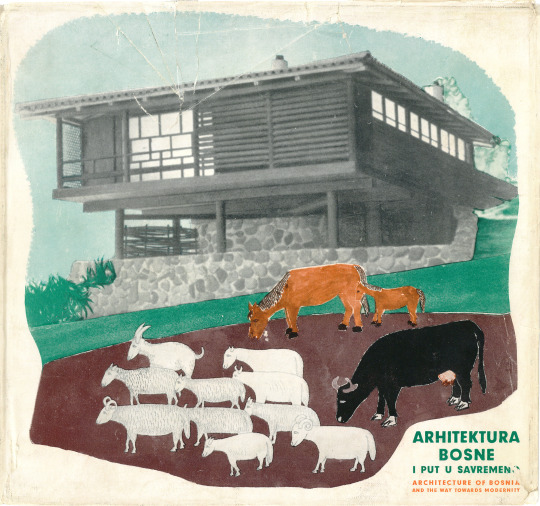
Architecture of Bosnia and the Way to Modernity by Dušan Grabrijan and Juraj Neidhard, Sarajevo 1957
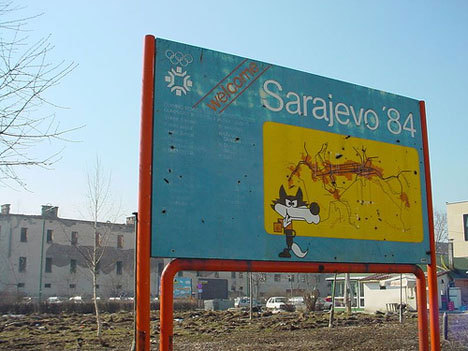
The 1984 Winter Olympics known as Sarajevo '84, was held between 8 and 19 February 1984 in Sarajevo, Yugoslavia.
Let's have a look of five impressive Forgotten Masterpieces in Sarajevo. Designed by Živorad Janković and Halid Muhasilović, Skenderija is a multi-functional cultural and sports centre completed in 1969. This building was the first of its kind in the former Yugoslavia and in many ways acted as a prototype for many similar complexes that were later built throughout the country. As such, Skenderija played a curial role in the development of not only the local architecture, but also of Yugoslavian modernist architecture as a whole. It was the first hybrid building in the former Yugoslavia that fused together many different functions (sports, performance, entertainment, shopping, food, service, etc.) within a singular multi-storey complex that employed a modernist aesthetics prevalent of the time.
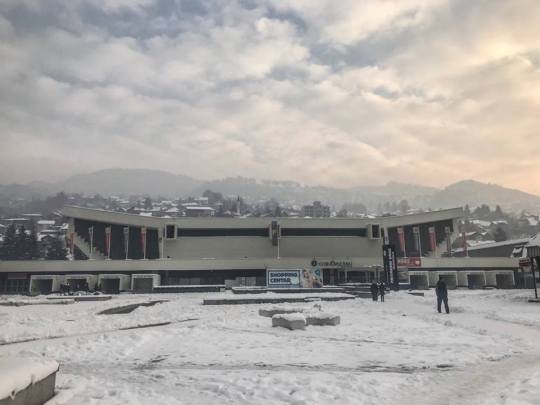
The complex consists of three buildings; a large sports hall in the first, a number of smaller sports halls in the second building and Dom Mladi (House of Youth) with cultural content in the third. | Photo Lejla Odobašić Novo
The buildings are arranged around an open plateau, a city agora, under which is located a subterranean commercial level with a circulation path that allows access all three buildings. The project was innovative in the complex construction system used that allowed for large spans. It also reflected the modernist ambition of honesty in the material use, with the concrete articulation of all the façades. In many ways, due to its scale and cultural significance, the complex shifted the symbolic gravitation from the old city centre and established an additional point of prominence. In urbanistic terms it expended the city beyond the exiting east-west axis and opened the south bank of the river Miljacka.


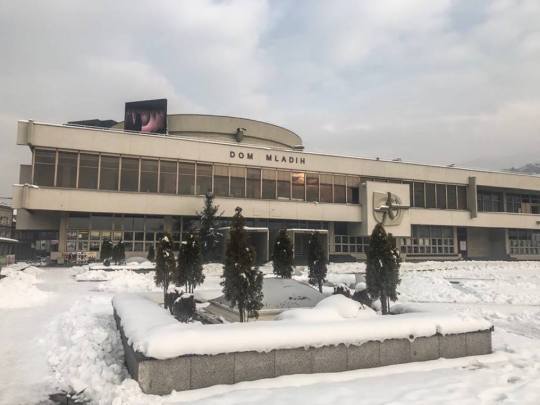
Skenderija allowed Sarajevo to take on a new cultural significance that would later be sealed by the Winter Olympics in 1984. | Photo Lejla Odobašić Novo
The Communist Party of Yugoslavia started the project of the Sarajevo’s main railway station as an architectural competition with the ultimate goal of physically uniting the country through its railway system. At the beginning of Socialist Yugoslavia, the country’s political views strongly aligned with those of the USSR and the remainder of the communist bloc. As such, Yugoslavian architecture at this time, although modernist in spirit was still heavily influenced by the social realism that was used as a political tool and prevailed in the majority of the eastern bloc countries.

The Railway station was opened in 1952 and in its thirty years of function, up until the siege in 1992, the building was one of the most monumental structures in Sarajevo. | Photo via Mirza Hasanefendic
Social realism in Sarajevo brought on a range of contradictions in its architectural articulation. It ranged from architecture for the masses most clearly articulated in the residential settlements for the worker’s housing to that of highly articulated and relatively well executed public buildings, mostly designed through architectural competitions.

The main railway station in Sarajevo reflects the complexity of a more western modernism. | Photo Lejla Odobašić Novo
Once the initial reconstruction phase after WWII was completed cultural and institutional buildings became the next phase of focus. One of these included the Ministry of Public Health. It is heavily modernist in nature, however, the social realist influence remains visible. It was built only a few years after the main railway station but the break away from the social realism is even more apparent in this case. This shift in architectural expression occurred as a direct result in the political and ideological drift between Yugoslavia and USSR.

The building relies on pure geometry, abstracted decoration in the form of vertical fins at the front façade, simplified openings and a receded top floor which allow for a terrace on the top floor. | Photo Lejla Odobašić Novo
The principal focus of the social realism buildings was an exaggerated scale in order to instill the notion of grandness of the state and to inspire deference towards the authorities, which in this case was the Communist Party of Yugoslavia. Since this building was designed and built as a Ministry of Public Heath, Ivanović strived to employ majority of these principles but he broke away from some keys aspect that defied socialist realism at the time.
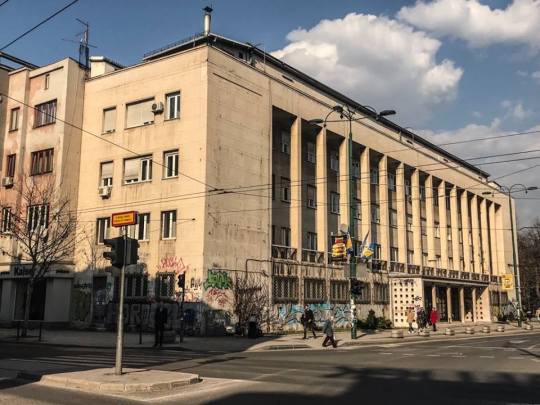
The building follows the rigid symmetry often employed by social realism and breaks a number of rules, which shift it towards a more ‘western’ modernist building. | Photo Lejla Odobašić Novo
The Communist party took control of Yugoslavia following the end of WWII in 1945. Like the majority of European cities, a considerable damage was suffered by the urban fabric in Yugoslavia as well. As such, one of the major tasks of the new socialist system was to rebuild as fast and as efficiently as possible. However, both the amount of resources and the number of available architects was limited and as such the initial wave of reconstruction was very utilitarian.
One of the most notable residential projects that dates back to the post-war period is the residential complex on Džidžikovac that resulted from a design competition set forth in 1947 and won by the above-mentioned Kadić brothers. The project was completed in just over a year which resulted in relatively poor construction quality, which was the case with many residential buildings constructed around this timeframe.

The design and the modernist spirit of the project render it as one of the most notable residential complexes in Sarajevo. | Photo Lejla Odobašić Novo
The complex contains three linear residential blocks each consisting of a number of three-storey interconnecting buildings that cascade along the existing topography. In addition, the three blocks are surrounded by open green space that integrates the building into the existing site forming a sense of a unified complex. Although the project has been declared as a protected national monument in 2008, the reconstruction done since the end of the siege in the 1995, has been to a large extent insensitive to the initial design principles of the Kadić brothers.
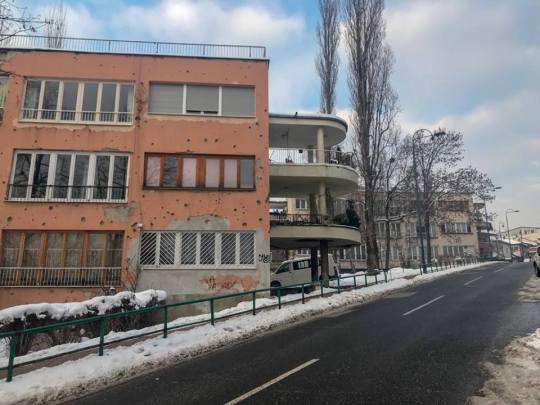
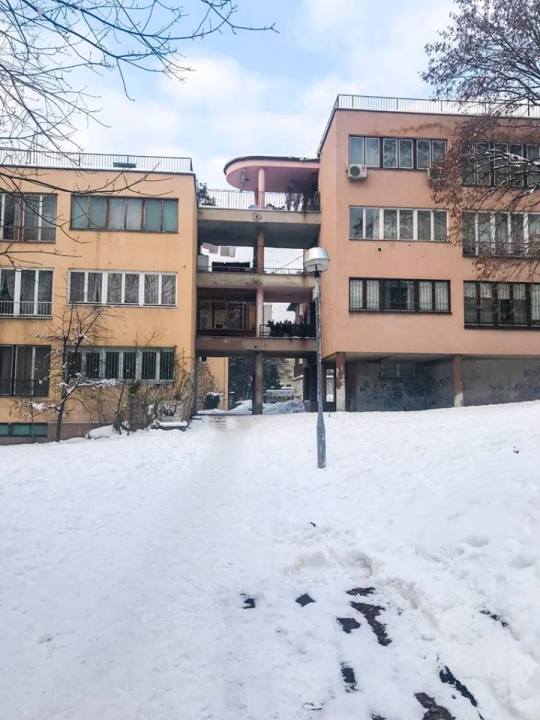

Each block have a set of semi-circular terraces suspended by receded columns - the signature feature of this project. | Photo Lejla Odobašić Novo
Completed in 1956, six years after the Ministry of Public Health, Residential Building and Šipad Headquarters breaks away from the social realist influence and draws inspiration from Oscar Niemeyer instead, thus creating one of the most prominent modernist buildings in Sarajevo.
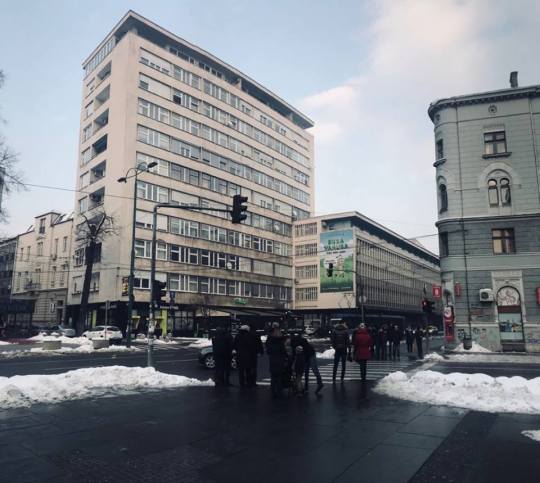
Although the two buildings are separate entities they lean on each other and share a part of the side wall. | Photo Lejla Odobašić Novo
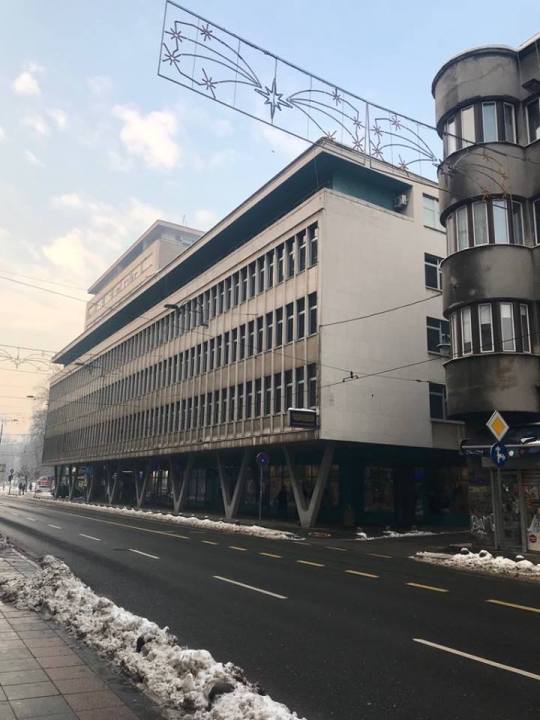

In order to allow for a continuous pedestrian flow, Ivanović frees part of the ground floor of the Šipad Headquarters, and thus creates a covered promenade lined with the distinct V shaped columns visually suspending the building off them. | Photo Lejla Odobašić Novo
---
#FOMA 44: Lejla Odobašić Novo

Photo by © Yasin Emir
Lejla Odobasic Novo is a Bosnian-Canadian architect and an architectural theorist who is currently working between Sarajevo and Toronto. She obtained her bachelor and master’s degrees from the University of Waterloo School of Architecture where she also held a research position and upon graduation worked as an Adjunct Professor at the Rome Campus. She holds a professional licence issued by the Ontario Association of Architects (2014) and is an Assistant Professor at the International Burch University in Sarajevo where she obtained her PhD and currently teaches architectural design and architectural theory. Lejla’s research focuses on the role of architecture, and in particular cultural heritage, in conflicted and contentious places. Within this field, she has carried out projects, exhibitions, publications and other cultural initiatives including her work with Liana Breser, Jerusalem-Sarajevo: In-between Cities, that was exhibited in Canada, UK, Bosnia and Croatia (2010-2011). She has also participated in DAAR Decolonizing Architecture residency and research group in the Palestine under Eyal Weizman, Sandi Hilal and Alessandro Petti (2010). Lejla is also a member of Kuma International, an International Center for the Visual Arts from Post-Conflict Societies. In addition to her academic work, she has also worked in architectural practices internationally including Toronto, London, Madrid, Rome and Istanbul.
49 notes
·
View notes
Text
What Is The Relevance Of Getting The Right Retail Interior Design

The purpose of getting the best retail interior in Kolkata is to draw the attention of clients aptly and make them notice your business. Let's know more.
One should not underestimate the power of interior design furniture and the retail business. An interesting piece of visual merchandising captures the attention of shoppers and empowers them to cross the store's threshold. Let us know more.
So, What Does Retail Interior Designing Do?
Think of millions of shoppers passing by the window of your shop. This is the only chance to grab their attention, almost the beginning of storytelling that you will continue even inside the store. The effective retail design honors the legacy of any space and also unites it with a store's architectural aspects of its location with the brand.
For instance, Apple's store in Covent Garden in London has a location in a historic building even though the brand has associations with modern technologies and innovation. By residing in the building and optimizing a retail design to develop a modern aesthetic within it, Apple pays a tribute to the local surrounding.
It is integral to retain the customer base for as long as possible since it increases the chances of forcing them to purchase. Modern customers are very busy and, commonly, they shop in a hurry. It is the responsibility of hall showcase designs interior retailers to slow down the journey and enhance the dwelling store time.
Techniques To Use:
One technique to do excellent retailing is by placing a huge, eye-catching display right at the entrance. Consumers tend to decide quickly if they like what they view when they first enter a space, so procuring something that stands out at the entrance encourages them to explore products further. We live in an extremely modern and digital world with a continuous push in the boundaries.
With a rising number of shoppers switching to e-commerce to purchase commodities, businesses need to make their retail stores interactive as well as enticing. Retail interior design permits brands with the opportunity to be bold with their spaces and also attract clients in a completely new manner.
Through bold designs and innovative signage, stores get the potential to develop an immersive environment that ensures the brand adheres to its policies and largely increases the possibility of a client returning. Besides, the decor is another integral consideration. Make Sure your brand's effort must match the decor and designs for the products to be sold effectively.
Conclusion:
Contact the best interior decorators in Kolkata, Outlook Interior to achieve the best retail design at affordable prices. We have a team of experts dedicating themselves completely to your projects. They treat your projects just like theirs and prioritize them. So, get in touch with them today and optimize quality retail interior services.
#bestretailinteriorinkolkata#interiordesignfurniture#bestinteriordecoratorsinkolkata#hallshowcasedesigninterior#outlookinterior
1 note
·
View note
Text
Affordable Architectural Services in Birmingham, UK.
Silicon EC UK Limited where we turn dreams into reality through innovative Architectural CAD Drawing Services United Kingdom. With years of experience and a passion for creativity, we are committed to delivering exceptional architectural solutions tailored to meet our clients' unique needs. We work closely with our client from the initial brainstorming session to the final delivery, the project head oversaw the entire process from inception to completion.

Visit Us Our Website :
#Architectural CAD Drawing Services United Kingdom#Architectural Site Plan London#Architecture Shop Drawing Liverpool#Architecture Interior Work UK#Architecture Landscape London#Architecture Visualization London#CAD Interior Designers United Kingdom#Architectural CAD Design United Kingdom#2D CAD Services UK#CAD Construction Services UK#Architectural Engineering Services#Architectural CAD Design Services#Architectural 3D Modeling Services#Architectural Engineering Company#Outsource Architectural CAD Services#Architectural CAD Drafting Services#Architectural Interior Design Services#Architectural Design and Drawing Services#Architectural Landscape Planning Services#Revit Architecture Services#Revit Architectural Engineering Services#2D Architectural Design and Drafting Services
0 notes
Text
Explore The Best Quality Shop Drawing Services Provider London, Canada

Silicon EC CA’s team of CAD drafters possess advanced technical expertise and a deep understanding of the Canadian architectural, engineering, and construction (AEC) industry, to offer you high-precision, industry-compliant Shop Drawing Services that cater to the specific requirements of architectural, structural, and MEP systems, ensuring seamless integration with project specifications and construction documentation.Our team produces highly detailed, dimensionally accurate, and fully coordinated drawings that facilitate error-free fabrication, installation, and on-site execution. We generate parametric, clash-free, and fabrication-ready shop drawings that align with material tolerances, load-bearing specifications, and field conditions.
We offer
Architectural Drafting and Architectural Drawings
MEP Shop Drawings Services
Rebar Shop Drawing Services
Steel Shop Drawing Services
Fabrication Drawings Services
Structural Shop Drawings Services
With a strong presence in the Canadian Building Industry, We provide comprehensive CAD Drawing services across Canada, delivering precise and fully coordinated drafting solutions for projects of all sizes and complexities.By working closely with fabricators, engineers, contractors, and project managers, we ensure that every drawing meets the unique demands of regional specifications and on-site conditions. Our commitment to technical accuracy, streamlined coordination, and efficient project execution allows us to support projects in major urban centers and remote locations alike, including Toronto, Vancouver, Montreal, Calgary, Edmonton, Ottawa, Winnipeg, Quebec City, Hamilton, and Kitchener, reinforcing our role as a trusted provider of high-quality shop drawings throughout the country.
For more details click on the link below
#cad drawings#shop drawings#structural drawings#rebar shop drawings#steel drawings#fabrication shop drawings#canada#cad services
0 notes
Text
Year 1 Week 1
year 1
week 1
day 1
identity and position 5th october
let the tutors know if there are any problems
independent work and collaborative work
learning on studios
developing self directed practise and presentation skills
manage your time 7th december is the deadline meet the deadlines make sure your meet the deadline you have opportunities to succeed take pictures of everything and record the work and the processes of the ideas and work to be professionals know what your work is about
day 2
day 2 (online class) 1000-1245
so we were asked 3 questions:
1. is illustration? A form of art communicating a message or showing a visual idea , recording a plant/ form of life in the wild recording an event unfolding before you (I remember seeing a painting on my trip to Russia of a massacre bloody Sunday) in fact in one could say Communist Russia and Germany when run by Adolf Hitler used art and radio to push their ideology and communicate a positive facade of their horrid plans for their respective countries.Especially illustration in newspapers which at the time people were an important part in human life especially in Europe.Your everyday reliant on newspapers to tell them the truth new shops to check out new restaurants to visit new products and services to buy,2. what is its purpose?- One's expression to bring joy or to just feel and create sometimes there is no reason you just felt like making something - to model or demonstrate a service ( a digital animated character walking) a potential product (iPhone 11pro), building,space,enviroment,scene,character etc.- to communicate ideas,views,opinions,thoughts,irony e.g political cartoons in british newspapers or films - to entertain / divert the masses - film/comic strips in newspapers or online,books,animation,games etc.- to make people think - painting or film or anything Banksy does his instagram is awesome 3. what can illustration do?anything literally it can impact all industries: helping pharmaceuticals and chemists on how to perform an experiment or how the lab should look the possibilities are endless- restaurant menus- visual ideas - storyboards for tv and films et design etc.- product design cars electric devices- where the fire exit signs- online training videos for companies animation for scenarios how to videos - a brand logo apple,The Walt Disney Company, the vue cinema logo etc.From wikipedia - ' Contemporary illustration uses a wide range of styles and techniques, including drawing, painting, printmaking, collage, montage, digital design, multimedia, 3D modelling. Depending on the purpose, illustration may be expressive, stylised, realistic or highly technical.Specialist areas include: Architectural illustration Archaeological illustration Botanical illustration Concept art Fashion illustration Information graphics Technical illustration Medical illustration Narrative illustration Picture books Scientific illustration' here are the groups i was in zoom group 5 answers :an interesting find i find whilst researching :/An illustration is a decoration, interpretation or visual explanation of a text, concept or process,[1] designed for integration in published media, such as posters, flyers, magazines, books, teaching materials, animations, video games and films. An illustration is typically created by an illustrator. Illustration also means providing an example; either in writing or in picture form.The origin of the word “illustration” is late Middle English (in the sense ‘illumination; spiritual or intellectual enlightenment’): via Old French from Latin illustratio (n-), from the verb illustrare' research sites:https://en.wikipedia.org/wiki/Illustration#:~:text=An%20illustration%20is%20a%20decoration,typically%20created%20by%20an%20illustrator. https://www.wordsense.eu/illustrare/ for me illustration is my expression whether via biro pen or watercolours etc. whatever medium this discipline can bring joy it can evoke an emotive memory it can inspire civilians to go to war and 'fight the huns' which many cartoons in newspapers did it during the first world war and second world wars.evoking a sense of comradery a call for heroes a call to 'do your bit' 'keep calm and carry on' and 'do your bit for the war effort'. illustration has the power to communicate an idea or various ideas therefore it has the ability to influence people and inspire and positive or negative reaction illustration and therefore art has power ...where do we get our info or inspo from?the internet - images,text,youtubecinema - filmstv- adverts games - ubisoft's assassin's creed 2,brotherhood what are you inspired by in accordance to the senses?Sensory integration is the process by which we receive information through our senses, organize this information, and use it to participate in everyday activities.An example of sensory integration is: Baby smelling food as they bring it to their mouth Tasting the food Feeling the texture Determining what this food is and if they want more https://pathways.org/topics-of-development/sensory/You read that right! Most people think there are just 5 sense, but there are actually 7! So what are the 7 senses?How might we use these senses in art Sight (Vision) - light the effect of light,everything we see nature social media,traditional media fine art in newspapers, film,photography,books,cartoon,animals,water,rocks,buildings and products,food, clothes,people etc.
Hearing (Auditory) - hearing a problem and trying to figure out how to fix it,hearing sound and figuring how to visualize it or incorporate it
Smell (Olfactory) - thinking of a memory how one felt at a specific time and trying to encapsulate that feeling that emotions and expressing that emotion or how one feels before during and after a smell e.g the air during a hot salty windy day at bournemouth beach
Taste (Gustatory) - memories,good food the feeling of gooey melting chocolate in my mouth trés delicieux!
Demonstrate that in a physical tangible state and or image whether it be traditional analogue on paper perhaps a 3D digital
Touch (Tactile) - textures and grains and movements of a rock of thing feathers and feeling and recreating that or recording it perhaps Vestibular (Movement) - the movement and balance sense, which gives us information about where our head and body are in space. Helps us stay upright when we sit, stand, and walk. - Dance the feeling of a wave hitting the rocks or water against you
Proprioception (Body Position): the body awareness sense, which tells us where our body parts are relative to each other. It also gives us information about how much force to use, allowing us to do something like crack an egg while not crushing the egg in our hands. - inspire to create an animation or a short film of various movements and how the character walks runs etc. various body movement prior to filming character development *FILM/TV/THEATRE mechanical horse like in war horse etc.
* Emotion and feeling - making people feel a different emotion or various emotions feeling empathy or anger making people feel inspired to better society
skills that I am confident in : paying Attention to detail
- Interpersonal and Communication Skills - Teamwork and Multi-tasking - Adobe Photoshop, Illustrator, Lightroom, InDesign, After Effects, Premier Pro and Capture One 10- Drawing- Painting- Illustration- Calligraphy- film and digital Photography as well as editing I care about and hope for :
Our World:- Education for everyone - ignorance is not bliss but a trap to be manipulated and controlled.Critical thinking discussions and emotional and mental growth is a positive thing is is an asset to society.Every human being able to have a full education for them and their needs if they are great at art and history they should not be shamed for not doing good in science!The current Prussian educational system is not helping everyone excel in the subjects they are good at - it was meant for military education in the ancient world after all however we need an improvement.Especially on the teachers hired and trained.Some countries are allegedly failing students just so that they can work in a specific manual labour industries when the kids are intelligent enough to be doctors and scientists they are purposefully failed and told to smash rocks or other manual labour jobs.
I care about the safety and innocence of the next generation globally for kids to be safe from men and woman who want to use them for their own benefit e.g greedy parents,predators,human traffickers and cult leaders
The ending of homeless (people being able to work and have their own home in the UK especially in London)
The end of human trafficking one human forcing another human being to do something for free and forcibly take away their own freedom their God given free will that is not okay to me that will never be okay we are all priceless.
1 note
·
View note
Text
Take a look at Amazing Attractions of Malaysia on Your Malaysia Excursions

Investigate Amazing Attractions of Malaysia on Your Malaysia Adventures
Bukit Indah
Many say it is usually wonderful, a few say the idea is fascinating, several declare it is charming desired destination, some say it is definitely abode on earth. Having whatever outline you explain Malaysia; tempted holidaying vacation spot of Okazaki, japan is further than visual along with verbal brief description. It is one of the lovely and charming place within Asia visited by simply enormous amounts of tourists from every one of the nook and corner around the globe. It is amazingly wonderful in addition to truly there usually are lots of things to help do to check out in Malaysia, which will undoubtedly get away from your spell join. Preceding all the astonishing as well as mesmerizing attractions be the item healthy beaches, man built attractions possibly the heritage and also cultural splendor, have manufactured Malaysia tour the preferred within tourists and honeymooning married couples.
Bukit Indah
Malaysia has many astonishing attractions which have lead for tourists to approach their tour according in order to all their choice. While a number of tourists desire for Malaysia Tours, many go regarding Malaysia Thailand adventures, shore tours or some insurance policy for fun filled memorable recreational tours in Malaysia. Anything tours you choose you actually will surly going to be able to having great new emotions, which you will like to see in intended for lifetime.
Some of often the Ought to Visit Attractions regarding Malaysia
Penang Literally significance area of betel peanuts, Penang is famous to get its mesmerizing organic beauty. The following tourists have loads of selections to make the morning a tremendous experience. The lovely comfy beaches, refreshing trees and shrubbery along with the mouthwatering cuisines draw in vacationers all the calendar year round.
Kuala Lumpur That vibrant capital involving Malaysia is home to quite a few intriguing attractions whose magnificence along with charm are not matched in addition to incomparable. Most connected with all the beautiful unification of the towering stones scrappers and the alluring heritage houses are the actual major draw associated with holidaymakers in Kuala Lumpur. Petronas Twin Tower, Stand Shopping center, Mardeka Square, Chinatown, Surai KLCC Mall, State Mosque, etc are some regarding the particular must and nearly all visit destination in Kuala Lumpur london of Malaysia.
Beside one could also find on to Kuala Lumpur Genting tour which is actually currently the most chosen by the tourists hunting some extra bit involving uniqueness inside this cash city. Genting tour supports all the activity as well as offers to all in spite of battle and love-making. Genting will be surrounded by means of the equatorial do and also is referred as typically the current entertaining hub inside the panel of dynamics. It is now transforming into the hub of web hosting service international events.
Perlis Noted for its unspoilt beauty, trees and scenic beauty, Perlis is the smallest status throughout Malaysia. The unspoilt trees and shrubbery and the glistering paddy grounds truly develop unbelievable perspective with just about every change connected with seasons.
Malacca It is a really sea side city for the West Coast of Peninsular Malaysia facing the straits of Malaysia. It is usually a value visiting urban center on Malaysia tour seeing that the city is definitely giving with heritage along with customs attractions. Its fantastic recent is clearly seen with the Portuguese architecture when while touring along often the lane; Chinese influence can certainly be seen considerably more certainly.
Beside these useful areas, one can also for you to Kelantan, Sabah, Sarawak, Terengganu, and so forth All these spots are blessed with brilliant tourism and attractions, which might be worth visiting and investigating on your trip to help Malaysia.
Currently, I begu to stop my very own performing finger from the Major boards. Hope this document will direct you towards planning Kuala Lumpur Genting Tours in addition to valuable specifics of worth checking out tourist's sites in Malaysia, Asia.
1 note
·
View note
Text
London Fire Brigade: Typeface | World Branding Forum
London Fire Brigade: Typeface | World Branding Forum
All Images courtesy of Foundry Types Designed by the Foundry Types in partnership with Studio Sutherl&, the London Fire Brigade’s new typeface looks back to the service’s lengthy history for inspiration, drawing on architecture, signage, fire engines, and the lettering seen on Victorian water pumps. The London Fire Brigade needed a typeface for certain touchpoints like its new shop and signage…

View On WordPress
0 notes
Text
Update: My Trip to China
Hi, all, it’s been an insane couple of months! Where have I been and why haven’t I been updating? Well, I’ve finally moved in a completely new place all by myself with a new job and lots of pleasant isolation in a tiny town by the sea. Right before that, my family took me overseas to China for a final family trip. I only got food poisoning twice. Oh, and I caught a cold. -v-
LONG POST UNDER THE CUT!!
Things I noticed that generally happen in China:
1) There are a lot of couples! Compared to Japan and Taiwan, I noticed the people here are more open about traveling and showing affection (and discourse) publicly. Where are the lonesome ones? Well, my brother deduced that because Chinese has so many people, the single people stay at home. TvT
2) Women like to cling onto arms or hold hands with their friends or lovers. My Shanghainese housemate was like this, too. I guess it’s a cultural thing.
3) Men tend to smoke, not women. You find women smoking sometimes, but it’s usually associated with being dirty and shameless. The men tend to cough and spit a lot. Everyone openly coughs and sneezes. There are no common words for “Excuse me” and “Bless you/Salud/Gesundheit/etc” in the Chinese language. It feels rude, but that’s how they are.
4) The subways are hi-tech. The navigation is better than Japan and Taiwan. The maps are friendly and easy to read for Chinese and English-literate people. Similar to an airport, however, you have to pass your bags and luggages through a scanning system and have your liquid containers examined before security allows you to board trains. The rides are cleaner.
5) In modern areas, everyone is very well-dressed. They have a fashion style evolved to incorporating modern and slightly retro looks. Unlike Taiwan and Japan, you don’t see people wearing traditional clothing unless it’s for shows or homely occasions.
6) There are cameras everywhere. It’s like London crosses the Patriot Act. Cameras on the highways, cameras on the streets, cameras in the subways. They use facial recognition and license plate recognition. A price of freedom to pay, but because of this system, we were able to track down one of our luggages that we left in a taxi cab. (Haha.) Security checked where my parents got off onto the subway, found the license plate of the taxi cab, and phoned the taxi driver to tell him to meet my parents at XX station to drop off their luggage.
7) They, uh, don’t like Japanese things in China. There are very few Japanese cars, buildings, and brands, going as far as vandalizing Japanese chain stores and boycotting products despite being safer and better. You can say it’s attributed to history and culture. Chinese people view self-humiliation in a different light. They can be quite envious.
8) Infrastructure is king. Not being political; from an objective outlook, the US spends a hefty amount of tax money on military. China invests in infrastructure. There are a lot of building projects going into apartments, museums, preserving historical sites, and parks and recreation. It’s at the point where national parks are completely paved and tiled. (Kinda defeats the purpose of national parks, but at least you don’t have to worry about muddy shoes.)
9) Local vendors that don’t belong to companies or corporations may sometimes be unsanitary, but the food quality is generally cheaper and tastier. Otherwise, if it wasn’t tasty, how would they sell?
10) Hype isn’t always a good thing. Just about every restaurant we’ve gone to where it was packed with people was just okay. Quiet hole-in-the-walls have a personable charm, quicker service, and equally if not better food. Real talk, the original ma po tofu shop serves tofu that is extremely spicy and bitter. Not worth it.
11) Public facilities like museums and libraries are taken quite seriously. The government believes when things are free, people are more civilized. Go figure, yet in my experiences, people were. Not sure about the museums since there’s a lot of Chinese history and culture to go through, anyway, but the public libraries are utilized to the fullest. You need identification to get inside, and every then, you’re only allowed to bring certain material into the library after going through a baggage and metal scan. There are lockers for your things. It was school time next to a university when I visited, so every seat was occupied with a busy Chinese scholar with a stack of books reviewing notes and practicing words or formulas. It was pretty surreal. I didn’t take pictures, but I’ll let you know there were very few fictional books where I visited.
12) Chinese people don’t listen to signs or tourist warning information. Seriously, as someone who’s part Chinese, myself, the tourists can be extremely disrespectful, and it’s super embarrassing. It’s usually the older generation because...well, if you know your history, you might know why they’re like this. But if it says no cellphones and pictures, you’ll find cellphones and pictures. Lower your sound? Someone’s yelling on their phone about the most trivial thing like what they ate for dinner. Stay on the path? Let me just hop this fence and proceed to head towards this dangerous slippery waterfall to take a mediocre selfie. Yeah, it wasn’t a great time. Someone like Germany would blow their brains out.
13) BRING YOUR OWN TOILET PAPER
I cannot stress enough how precious soft butt paper is. The kind they sell in China are sandpaper scrolls on your tender cheeks. Bring your own tp from home if you are to survive the plight of the outdoor public restroom. And soap or sanitizer. There is normally running water in bathrooms, but no soap! What’s the point if the bacteria is going to spread through the water?! Be prepared for squatting, turds, smells, and wet rims. Unless you stake out in your western hotel all day, you WILL find a squat toilet, and there is a high chance it WILL smell or be mysteriously slippery.
Anyway, here are some pictures I lazily took. The descriptions are all on the top of the photos.
We went to Shanghai first. The people are meh at best. But the architecture is interesting because of the heavy western influences. (Missing obligatory picture of The Bund because I exported it somewhere else.)

Beef noodle soup! My favorite! I like it with a little spiciness. They made the noddles with a knee paddle. Only $2 USD!

I’m not sure how to explain it correctly, nor do I know what the exact name of the method used to make the noodles is. I tried to explain it in the crude drawing I made below.

.
..
...
This is KFC.

The majority of the trip was spent in Chengdu in Sichuan Province. It’s hot and humid in the summer, but it was just right when we went.
There are a lot of open markets. Look at all the meat and produce! They even had morel mushrooms. Too bad we didn’t have a stove or butter in our hotel.
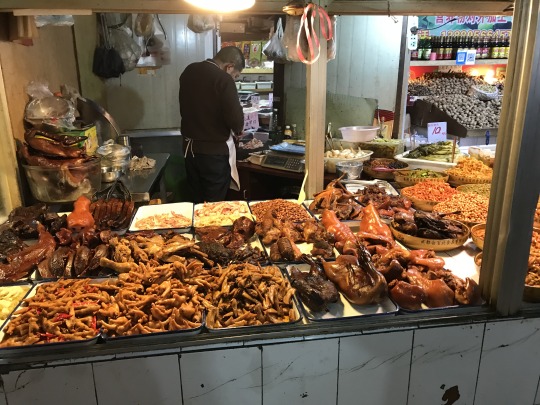

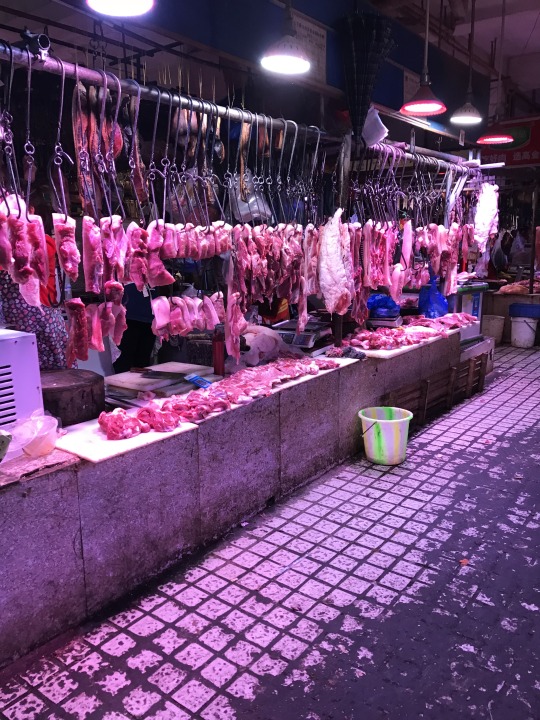
We visited Kuanzhai Street, a historical alley consisting of wide and narrow paths with historical buildings. Its initial intent is to let tourists experience some of the old culture of China, but nowadays, there are a bunch of vendors who try to capitalize on how many people go there. It gets very crowded.


A most mysterious wall of memes.
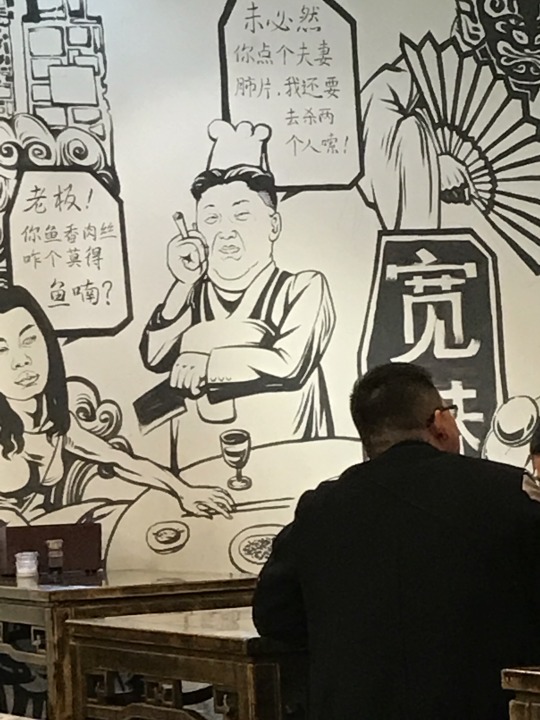
Not bad.
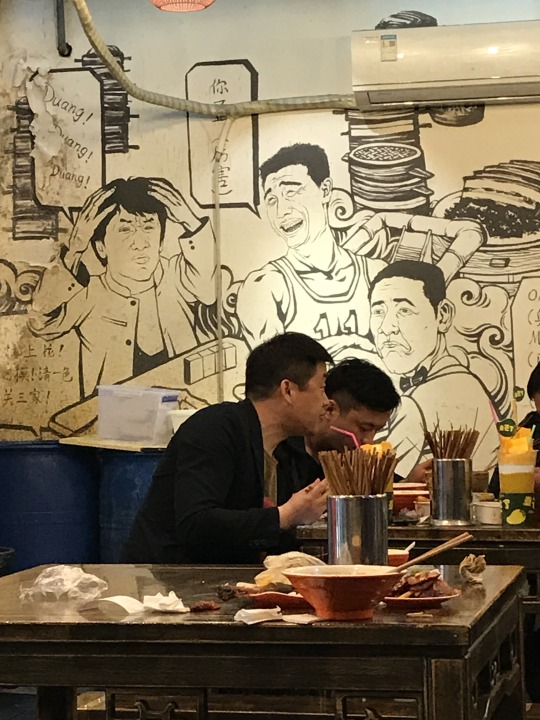
Sugar-blown rooster! It tastes like those rainbow lollipops you sometimes see at fairs or candy shops. You get to blow up the sugar, yourself. An interactive show. :)

Burnt sugar rooster! It tastes like the top of a creme brûlée.

Went on a tour to a panda rehabilitation center. Chengdu is a popular spot for earthquakes, and the one in 2017 left pandas injured and traumatized. This place helps them recuperate until they’re well enough to go back to the public zoos. Outside to greet us was a 5-some of panda statues. The one that stood out was the one on the far right with one leg. I thought he was just leaning his leg behind him, but it turns out, his leg is missing! Affirmative action?

(Missing black and white panda because my good captures were all videos.) The red panda tails are so fluffy and gravity-defying. The tails are like a foot long and stay straight in the air.

A Tibetan-like feast! You eat with your hands, and they give you gloves. Everything was fresh and tasty. They served us yak milk. It tastes like if you mix 1 part milk, 2 parts water, so it’s not bad if you don’t mind the watery taste. Over here, your wealth is measured by the number of white yaks you own.
I’m missing pictures, but there was a good number of performances with singing, dancing, and conga lines at our table. My dad got really into it. Because some Chinese cultures are normally reserved, they weren’t used to his disco dancing. Later, they called him Uncle Buddha. And they said he looked high.

Jiuzhaigou. It was closed since the 2008 earthquake due to high levels of mountain and road collapses. It opened recently, so the locals were surprised to hear that it was open again. You can even take pictures wearing local minority Chinese garb. I think it was around $3 USD, but we needed to haul butt.
WATCH THE PICKLE!! We stayed at a decent hotel, but a popular breakfast dish in China is porridge with various kinds of pickled vegetables. I figured I needed vegetables to help me “go” easier during our travels, so I ate a little of everything. So did my dad. My brother and surprisingly my mom, who eats more veggies than anyone in our family, skipped out. Two hours of a bus ride later, I threw up on the street. My dad threw up minutes after I did. We’re pretty sure the old used for the spicy pickle was stale.
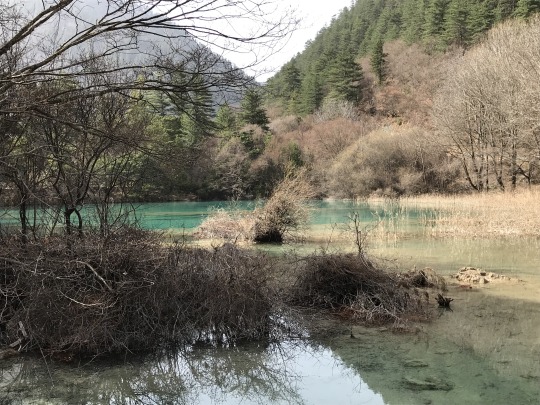


Eh, what can you do?

A clear limestone lake. Surprisingly not many people here. It was also very quiet and clean.
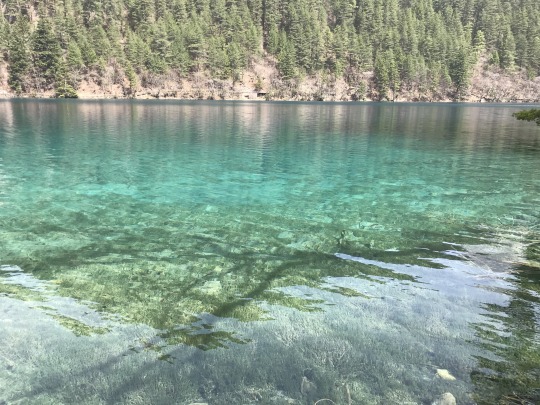
We went to Leshan to see the giant Buddha. It’s not too bad of a walk, maybe because it’s at sea level. (Two days prior, Jiuzhaigou was at 7000ft/2100m, so it was really hard to hike without getting tired.) This thing is HUGE. You might be able to see tiny people in the upper right-hand corner for scale. Only take pictures on the Buddha’s right side!
By the way, there are a lot of little statues and tiny Buddha carvings littered on the hike up there. Per Chinese superstition, you are not supposed to take pictures of them. Some either house evil spirits that you can take home with you or you might trap good spirits from spreading fortune.
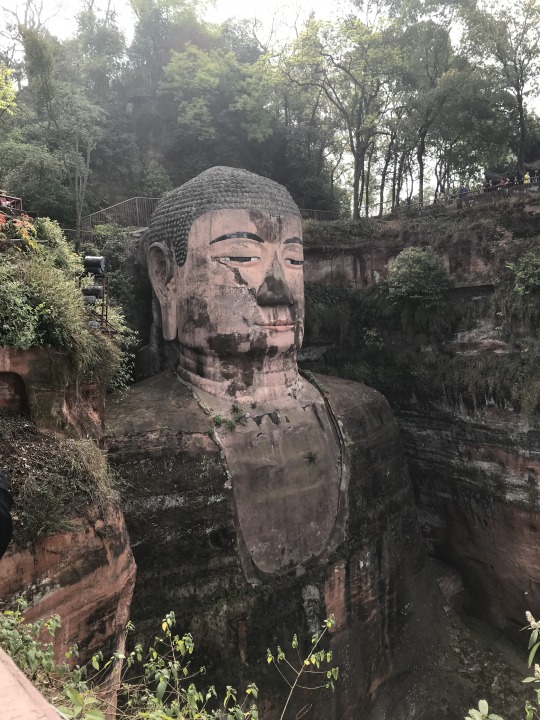
Very pretty architecture behind the statue. You can drink tea here for about $5, however, it’s a tourist trap! Don’t waste your money and time. See how these pictures don’t have tourists in them? It’s because they were all caught up drinking tea and sitting on their butts.


Aw, the picture rotated. Anyway, here’s a fly modern monk with Nike’s and a smartphone.

Kinda mad I can’t remember this place, but there were many elephant themes in this tourist town we visited. My brother (listed in the picture below with the ONLY pair of long pants and jacket he stupidly packed for the 12-day trip) found a mantou shop that sells these long buns for only 1 YUAN. That’s like $0.17 USD. As a bun advocate, he said they were tasty.

DPRAUNNDKA (Someone was drunk, alright.)


Hot pot! Taiwan was better, and the Guangdong guys were too afraid to try to spicy broth. (Like Hong Kong, haha. Because Cantonese people don’t like spicy food, according to Himaruya.) It was okay, but we only had 30 minutes to eat before catching a show. I don’t have pictures, but the sets and performances were really cool!

Gelatins! Sketchy at best but tasty-looking!

A pleasant view of the hike up Umeishan. Right past this chasm are monkeys! If I panned my phone down, you would’ve seen trash. This is from the monkeys eating tourists’ food. You have to watch your pockets and bags because they’ll go through them for kicks, usually not even for food. And don’t wear red because it intimidates them.
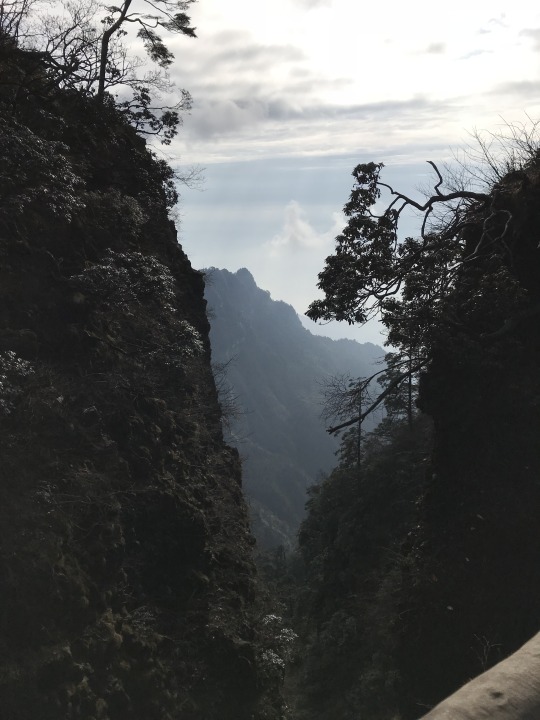
You can hire rickshaw(?) carriers to take you up the mountain. Great for elderly or lazy people. I think it’s about $32 per way.

Famous Emeishan statue thing. You are supposed to take pictures relevant to your zodiac sign, so there are twelve positions like a clock. It’s COLD up there. But the hike makes you warm! And there’s a cable cart that takes you up most of the way.

Zoomed-in luna month friend. It was behind a temple door. The wings looked so soft.

I forgot what this trail was called. The whole hike was about 7 km. Supposed to be 10, but it started to rain, so we skipped the end. Lots of tourists in places, but very nice scenery. Walk fast to avoid smokers. Why do they smoke while walking? :/
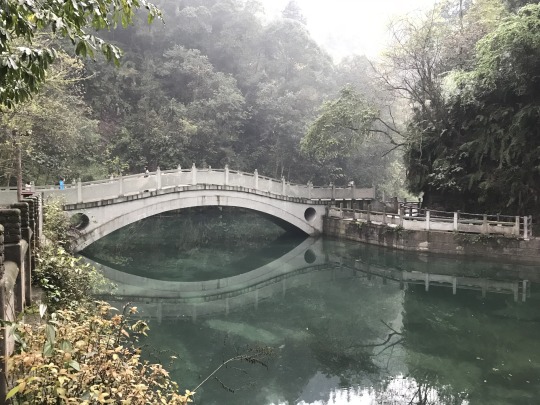


Beer Garden in Chengdu City. It’s a strip of bars and clubs where foreigners can sing American pop songs and drink beer. Lots of “trashy” women with rich drunk men. It’s an insane atmosphere with rich-looking people and every bar being full. Seriously. I’d show more pictures, but you really need a video to get an idea of the vibe. Here’s one of Goose Island, whatever that means. Next to it were two hedge sheep. Look at this shit, there’s a picture of the White House on the poster! Ahhh! XD

Chengdu Global Center Mall
Cheese and rice, I thought Tokyo’s AEON Laketown mall was huge. This place has a hotel and a water theme park built into it with a grocery store and food court in the basement. At this point, my family’s feet hurt from all the walking. -.-’

Boo. We came too late. All the boba was sold out. Hey, cat poop coffee on the top.

Just why?




Last full day in Chengdu. Here’s the outside of the museum. You have to wait in line to get screened before going in, however, it’s free.

An underground strip mall. Okay here me out, we tried very hard to look for bootleg Chinglish shirts, but we could NOT find any. The Chinese locals seemed to either snatch them up or we weren’t looking in the right places.

lol and that’s it. We went back to Shanghai for a full day after that, but I caught major food poisoning from something I ate. It was bad. My bowels felt all twisty and uncomfortable. So I spent the entire day in the hotel while my family had a blast eating food and looking at architecture. My brother found a slew of funny Chinglish menus. I wish I had the pictures. If I find them, I’ll pass them along.
Thanks for reading and I’ll try to update stuff when I get settled down in my new place. :3
100 notes
·
View notes
Photo




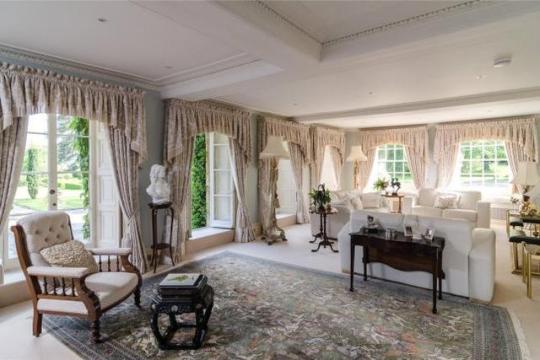
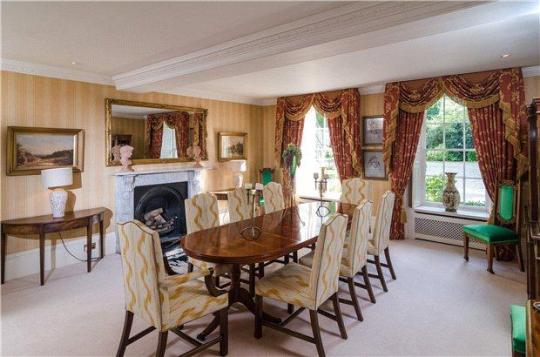

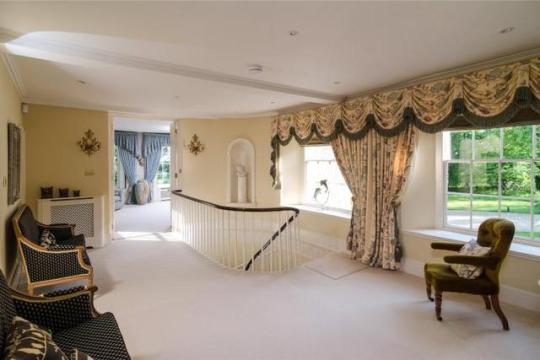
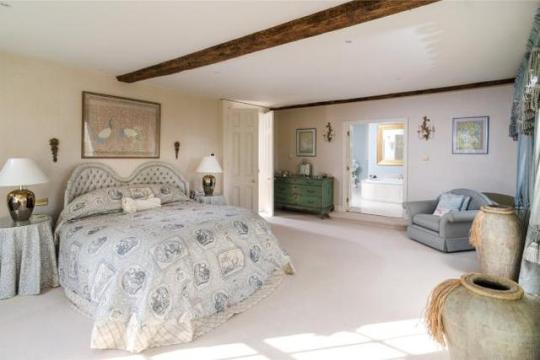
Description
Holt Manor is a significant Grade II listed manor house which dates back to the 17th century with later additions in the 18th and 19th centuries. The house sits in an extremely private and peaceful setting on the edge of the village of Holt.
The house is approached over a gravelled carriage drive through impressive entrance gates to a turning circle which reveals a stunning picture of a very pretty house. The driveway continues to a courtyard to the side of the house which is surrounded by outbuildings. The house is constructed of traditional stone with a Welsh slate roof. The house has been modernised beautifully and has retained all of its charm and character, including original sash windows and high ceilings. The accommodation at Holt Manor flows very neatly, the impressive hallway is at the heart of the house with a fine cantilevered staircase which leads to the galleried landing. The principal drawing room has five French doors which lead out to a beautiful formal garden with charming views of the parkland beyond. The dining room leads from the opposite side of the hallway, and gives access to the library and study. Near to the family sitting room and playroom the kitchen is perfect for family life and is fully equipped with integrated appliances. From the kitchen there are excellent views of the walled garden. Domestically the large boot room and utility room are beyond the kitchen and a vital part of family life. Upstairs the master bedroom has a lovely view of the gardens and parklands to the east and south. This bedroom is filled with a wealth of early morning light. The impressive bathroom leads to an excellent dressing room. There are 4 further bedrooms (3 en-suite) on the fi rst fl oor, a further family bathroom and 2 separate dressing rooms. The second floor offers an attic flat with sitting room, 2 bedrooms and bathroom perfect for guests or teenage children. Holt Manor is located in a private and peaceful setting on the edge of the village of Holt, in a part of Wiltshire known for its pretty villages and large country estates. It sits in an elevated position, enjoying beautiful views over its parkland and the surrounding countryside. The historic town of Bradford-on-Avon is 3 miles away and is famed for its Georgian architecture and historic bridge over the River Avon. It has excellent local shopping and an array of superb restaurants. Further afield is the Georgian City of Bath which offers an extensive range of amenities including shopping, restaurants and theatre. There is Premiership rugby on the Recreation Ground and Bath also has two excellent universities. The area is renowned for its well regarded schooling with Stonar School within 3 miles. In addition Prior Park, King Edwards, Monkton Combe, Kingswood and The Royal High School all in Bath. Further afield are St Mary’s Calne, Dauntseys, Millfield and Marlborough College. There are also good state schools in the area. Road and rail links from Holt Manor are excellent. There is a regular service to London Paddington both from Chippenham and Bath Spa stations. Access to the M4 is via junction 17 (15 miles) providing a fast link to Bristol, London and Heathrow Airport. Bristol Airport is 30 miles away. Gardens and Grounds The gardens at Holt Manor have been designed and maintained beautifully over the years. The gardens are separated from the parkland on the eastern boundary by a stone ha-ha. The main terrace, which leads from the drawing room, overlooks the Italianate garden and parkland beyond. Neat gravel paths intersect the immaculate lawns. The terrace leads through to an arboretum which provides a peaceful woodland walk surrounded by a number of mature deciduous trees. The walled garden to the rear of the house is a perfect hideaway, with intricate planting, a neat vegetable garden and an automatic watering system. Beyond the walled garden is an orchard with a number of mature fruit trees and the hard tennis court. Outbuildings There are a number of beautifully constructed and maintained outbuildings at Holt Manor. Directly north of the main house is a former Brew House and nearby is a former stone built stable block of similar proportions.
2 notes
·
View notes
Text
Get the Best Shop Drawing Services in Liverpool, United Kingdom

Silicon EC UK Limited stands as a beacon of excellence in providing prime Shop Drawing Services in Liverpool, UK. Our team of experienced draftsmen and engineers is dedicated to delivering high-quality shop drawings that align precisely with the project requirements and specifications. We collaborate closely with you from the outset, meticulously interpreting your drawing intent and translating it into an optimized structural framework. We leverage the latest software tools and technologies to create comprehensive drawings that cover every aspect of the construction process, from structural components to mechanical, electrical, and plumbing systems.
Choose Silicon EC UK Limited for your shop drawing needs in Liverpool, UK, and experience the difference that our commitment to excellence can make in bringing your vision to life. Contact us today to learn more about our Outsource Shop Drawing Services and how we can support your next Shop Drawing project.
For More Details Visit our Website:
#Shop Drawing#Shop Drawing Services#Shop Drawing Services London#Shop Drawing Company London#Engineering Company#Engineering Service#Engineering Firm#Fabrication Drawings Services#Assembly Shop Drawing Services#Erection Shop Drawing Services#BIM Shop Drawing Services#Steel Shop Detailing Services#CAD Shop Drawing Services#Rebar Shop Drawing Services#Precast Shop Drawing Services#HVAC Duct Shop Drawing Services#MEP Shop Drawing Services#2D Shop Drawing Services#Joinery Shop Drawings Services#Architectural Shop Drawing Services#Millwork Shop Drawing Services#Outsourcing Shop Drawing Services#Structural Shop Drawings Services#Drafting Shop Drawings#Structural Shop Drawings#Duct Fabrication Drawing#Structural Shop Drawing Service
0 notes